A System Thinking Approach to Circular-Based Strategies for Deep Energy Renovation: A Systematic Review
Abstract
1. Introduction
- How can circular economy principles enhance the effectiveness and long-term sustainability of deep energy renovations in the EU?
- What are the key barriers and enabling factors for integrating circular economy principles into deep energy renovation policies and practices?
2. Materials and Methods
- Primary concepts from research question (e.g., Circular Economy, Deep Energy Renovation, Energy Efficiency).
- Synonymous and related terms to address variations in terminology, as detected in key policies and the literature (e.g., “Building Retrofitting” for Deep Renovation, “Material Reuse” for Circular Economy).
- Boolean operators are applied to refine the search and improve relevance.
- Variables, represent critical factors influencing CE-DER adoption (e.g., financial incentives, material reuse, etc.)
- Arrows, indicate the causal relationships between the variables.
- Polarities, defining whether they are reinforcing (+) (amplifying effects over time) or balancing (-) (counteracting effects to stabilize the system).
Data Collection and Screening—Literature Search Strategy
- Years: 2015–2025 (ensuring that the focus remained on recent advancements in the field of circular economy and deep energy renovations)
- Language: English.
- Types of work in WoS: articles, review articles and book chapters.
- Types of work in Scopus: articles, reviews, and book/book chapters.
- Research area: there are differences between WoS and Scopus, as shown in Table 2 below.
3. Results
3.1. Integrated Bibliometric Analysis
- Technical Enablers;
- Economic and policy barriers;
- Social Sustainability Factors;
- Environmental Considerations;
- Digitalization and Data-Driven Systems for Climate Resilience.
3.2. Thematic Cluster Analysis
- (1)
- Technical Enablers (Dominant but Siloed)
- (2)
- Economic and policy barriers (Underdeveloped and Weak Connections)
- (3)
- Social Sustainability Factors (Marginalized in Research Priorities)
- (4)
- Environmental Considerations (Well Represented but Poorly Integrated)
- (5)
- Digitization and Data-Driven Systems for Climate Resilience (Poorly interlinked with CE and DER)
3.3. Causal Loop Analysis of Systemic Dynamics in CE-DER
- (1)
- Technical Enablers
- (2)
- Economic and Policy Barriers
- (3)
- Social Sustainability Factors
- (4)
- Environmental Considerations
- (5)
- Digitization and Data-Driven Systems for Climate Resilience
4. Discussion
4.1. Understanding Systemic Feedback: Barriers and Reinforcers
4.2. Policy Coherence, Social Trust, and Digital Governance
4.3. Strategic Leverage Points for a Scalable Transition
4.4. Limitations of the Research
5. Conclusions
Author Contributions
Funding

Data Availability Statement
Conflicts of Interest
Abbreviations
| CE | Circular Economy |
| CLD | Causal Loop Diagram |
| DER | Deep Energy Renovation |
| EU | European Union |
References
- BPIE. The Renovation Wave Strategy & Action Plan: Designed for Success or Doomed to Fail? BPIE: Brussels, Belgium, 2021. [Google Scholar]
- Oliveira, R.; Almeida, R.M.S.F.; Figueiredo, A.; Vicente, R. A Case Study on a Stochastic-Based Optimisation Approach towards the Integration of Photovoltaic Panels in Multi-Residential Social Housing. Energies 2021, 14, 7615. [Google Scholar] [CrossRef]
- Ruggieri, G.; Andreolli, F.; Zangheri, P. A Policy Roadmap for the Energy Renovation of the Residential and Educational Building Stock in Italy. Energies 2023, 16, 1319. [Google Scholar] [CrossRef]
- Pombo, O.; Allacker, K.; Rivela, B.; Neila, J. Sustainability Assessment of Energy Saving Measures: A Multi-Criteria Approach for Residential Buildings Retrofitting—A Case Study of the Spanish Housing Stock. Energy Build. 2016, 116, 384–394. [Google Scholar] [CrossRef]
- Lynn, T.; Rosati, P.; Egli, A. Deep Renovation: Definitions, Drivers, and Barriers. In Disrupting Buildings Digitalisation and the Transformation of Deep Renovation; Lynn, T., Rosati, P., Krinidis, S., Kennedy, J., Eds.; Palgrave Macmillan: Dublin, Ireland, 2023; Volume 1, pp. 1–22. [Google Scholar]
- Kaewunruen, S.; Teuffel, P.; Donmez Cavdar, A.; Valta, O.; Tambovceva, T.; Bajare, D. Comparisons of Stakeholders’ Influences, Inter-Relationships, and Obstacles for Circular Economy Implementation on Existing Building Sectors. Sci. Rep. 2024, 14, 11046. [Google Scholar] [CrossRef] [PubMed]
- Mercader-Moyano, P.; Ramos-Martín, M. Comprehensive Sustainability Assessment of Regenerative Actions on the Thermal Envelope of Obsolete Buildings under Climate Change Perspective. Sustainability 2020, 12, 5495. [Google Scholar] [CrossRef]
- Passoni, C.; Palumbo, E.; Pinho, R.; Marini, A. The LCT Challenge: Defining New Design Objectives to Increase the Sustainability of Building Retrofit Interventions. Sustainability 2022, 14, 8860. [Google Scholar] [CrossRef]
- Fowler Davis, S.; Davies, M. Understanding the Effects of Social Cohesion on Social Wellbeing: A Scoping Review. Int. J. Public Health 2025, 70, 1607414. [Google Scholar] [CrossRef]
- Baker, E.; Moore, T.; Daniel, L.; Caines, R.; Padilla, H.; Lester, L. Sustainable Social Housing Retrofit? Circular Economy and Tenant Trade-Offs. AHURI Final Rep. 2023, 397, 1–22. [Google Scholar] [CrossRef]
- BPIE. Accelerating Deep Renovation in the EU with Renovation Passports: EU Roadmap Proposing Concrete Measures to Maximise the uptake of IBRoad2EPC Schemes; BPIE: Brussels, Belgium, 2024. [Google Scholar]
- Sáez-de-Guinoa, A.; Zambrana-Vasquez, D.; Fernández, V.; Bartolomé, C. Circular Economy in the European Construction Sector: A Review of Strategies for Implementation in Building Renovation. Energies 2022, 15, 4747. [Google Scholar] [CrossRef]
- Van Ooschot, J.; Maggio, M.S.; Vel, P.; Tisov, A. Boosting the Renovation Wave with Modular Industrialized Renovation Kits: Mapping Challenges, Barriers, and Solution Strategies; Huyge; Architects’ Council of Europe: Brussels, Belgium, 2022. [Google Scholar]
- EEA. Addressing the Environmental and Climate Footprint of Buildings; EEA: Copenhagen, Denmark, 2023. [Google Scholar]
- European Commission. A New Circular Economy Action Plan for a Cleaner and More Competitive Europe; European Commission: Brussels, Belgium, 2020. [Google Scholar]
- Ürge-Vorsatz, D.; Khosla, R.; Bernhardt, R.; Chan, Y.C.; Vérez, D.; Hu, S.; Cabeza, L.F. Advances Toward a Net-Zero Global Building Sector. Annu. Rev. Environ. Resour. 2020, 45, 227–269. [Google Scholar] [CrossRef]
- De Wolf, C.; Hoxha, E.; Hollberg, A.; Fivet, C.; Ochsendorf, J. Database of Embodied Quantity Outputs: Lowering Material Impacts Through Engineering. J. Archit. Eng. 2020, 26, 04020011. [Google Scholar] [CrossRef]
- Fogarassy, C.; Horvath, B. Climate Policy Cost-Benefit Model Application for Successful Central European Building Retrofitting Programs—A Hungarian Case Study. Int. J. Eng. Bus. Manag. 2017, 9, 1847979017717574. [Google Scholar] [CrossRef]
- Thomas, S.; Schnurr, B.; Wagner, O. Net Zero Building Renovations: How Can Both Climate Justice and Social Equity Objectives Be Achieved? European Council for an Energy Efficient Economy: Hauts-de-France, France, 2024. [Google Scholar]
- Almeida, M.; Ferreira, M.; Barbosa, R. Relevance of Embodied Energy and Carbon Emissions on Assessing Cost Effectiveness in Building Renovation-Contribution from the Analysis of Case Studies in Six European Countries. Buildings 2018, 8, 103. [Google Scholar] [CrossRef]
- D’Oca, S.; Ferrante, A.; Ferrer, C.; Pernetti, R.; Gralka, A.; Sebastian, R.; Veld, P.O. Technical, Financial, and Social Barriers and Challenges in Deep Building Renovation: Integration of Lessons Learned from the H2020 Cluster Projects. Buildings 2018, 8, 174. [Google Scholar] [CrossRef]
- Meadows, D. Thinking in Systems—A Primer; Wright, D., Ed.; Earth Scan: London, UK; Sterling, VA, USA, 2008. [Google Scholar]
- Van Eck, N.J.; Waltman, L. VOSviewer Version 1.6.20; Centre for Science and Technology Studies (CWTS), Leiden University: Leiden, The Netherlands, 2023; Available online: https://app.vosviewer.com (accessed on 18 March 2025).
- Anderson, V.; Johnson, L. Systems Thinking Basics from Concepts to Causal Loops; Pegasus Communications: Cambridge, MA, USA, 1997. [Google Scholar]
- Kim, D.H. Guidelines for Drawing Causal Loop Diagrams. In The Systems Thinker; Pegasus Communications: Cambridge, MA, USA, 1992; Volume 3, Issue 1; pp. 5–6. [Google Scholar]
- Ventana Systems, Inc. Vensim User’s Guide and Reference Manual; Ventana Systems, Inc.: Harvard, MA, USA, 2024; Available online: https://vensim.com/documentation/users_guide.html (accessed on 2 March 2025).
- Pranckutė, R. Web of Science (WoS) and Scopus: The Titans of Bibliographic Information in Today’s Academic World. Publications 2021, 9, 12. [Google Scholar] [CrossRef]
- Zhu, J.; Liu, W. A Tale of Two Databases: The Use of Web of Science and Scopus in Academic Papers. Scientometrics 2020, 123, 321–335. [Google Scholar] [CrossRef]
- Ghisellini, P.; Cialani, C.; Ulgiati, S. A Review on Circular Economy: The Expected Transition to a Balanced Interplay of Environmental and Economic Systems. J. Clean. Prod. 2016, 114, 11–32. [Google Scholar] [CrossRef]
- van der Schoor, T. Lessons from EU-Projects for Energy Renovation. Urban. Plan. 2022, 7, 123–130. [Google Scholar] [CrossRef]
- Sánchez Ramos, J.; Guerrero Delgado, M.C.; Álvarez Domínguez, S.; Molina Félix, J.L.; Sánchez de la Flor, F.J.; Tenorio Ríos, J.A. Systematic Simplified Simulation Methodology for Deep Energy Retrofitting Towards NZE Targets Using Life Cycle Energy Assessment. Energies 2019, 12, 3038. [Google Scholar] [CrossRef]
- Wu, R.; Mavromatidis, G.; Orehounig, K.; Carmeliet, J. Multiobjective Optimisation of Energy Systems and Building Envelope Retrofit in a Residential Community. Appl. Energy 2017, 190, 634–649. [Google Scholar] [CrossRef]
- Storck, M.; Slabik, S.; Hafner, A.; Herz, R. Towards Assessing Embodied Emissions in Existing Buildings LCA—Comparison of Continuing Use, Energetic Refurbishment versus Demolition and New Construction. Sustainability 2023, 15, 13981. [Google Scholar] [CrossRef]
- Antonov, Y.I.; Heiselberg, P.K.; Pomianowski, M.Z. Novel Methodology toward Nearly Zero Energy Building (NZEB) Renovation: Cost-Effective Balance Approach as a Pre-Step to Cost-Optimal Life Cycle Cost Assessment. Appl. Sci. 2021, 11, 4141. [Google Scholar] [CrossRef]
- Antonov, Y.I.; Heiselberg, P.; Flourentzou, F.; Pomianowski, M.Z. Methodology for Evaluation and Development of Refurbishment Scenarios for Multi-Story Apartment Buildings, Applied to Two Buildings in Denmark and Switzerland. Buildings 2020, 10, 102. [Google Scholar] [CrossRef]
- Kuusk, K.; Kalamees, T. Retrofit Cost-Effectiveness: Estonian Apartment Buildings. Build. Res. Inf. 2016, 44, 920–934. [Google Scholar] [CrossRef]
- Abbà, I.; Crespi, G.; Vergerio, G.; Becchio, C.; Corgnati, S.P. Key Performance Indicators for Decision Support in Building Retrofit Planning: An Italian Case Study. Energies 2024, 17, 559. [Google Scholar] [CrossRef]
- Dey, S.; Veerendra, G.T.N.; Aparna, O. A Systematic Analysis of Retrofitting Tools in the Residential Buildings to Improve the Energy Performances by Using the STAAD Pro Software. Innov. Infrastruct. Solut. 2023, 8, 221. [Google Scholar] [CrossRef]
- Gubert, M.; Ngoyaro, J.A.; Gutierrez, M.J.; Pinotti, R.; Brandolini, D.; Avesani, S. Comparative Cost Analysis of Traditional and Industrialised Deep Retrofit Scenarios for a Residential Building. J. Facade Des. Eng. 2023, 11, 145–168. [Google Scholar] [CrossRef]
- Nigumann, E.; Kalamees, T.; Kuusk, K.; Pihelo, P. Circular Renovation of an Apartment Building with Prefabricated Additional Insulation Elements to Nearly Zero Energy Building. J. Sustain. Archit. Civil. Eng. 2024, 34, 22–34. [Google Scholar] [CrossRef]
- Niemelä, T.; Kosonen, R.; Jokisalo, J. Cost-Effectiveness of Energy Performance Renovation Measures in Finnish Brick Apartment Buildings. Energy Build. 2017, 137, 60–75. [Google Scholar] [CrossRef]
- Walker, L.; Hischier, I.; Schlueter, A. The Impact of Modeling Assumptions on Retrofit Decision-Making for Low-Carbon Buildings. Build. Environ. 2022, 226, 109683. [Google Scholar] [CrossRef]
- Seo, S.; Foliente, G. Carbon Footprint Reduction through Residential Building Stock Retrofit: A Metro Melbourne Suburb Case Study. Energies 2021, 14, 6550. [Google Scholar] [CrossRef]
- Szymańska, E.J.; Kubacka, M.; Woźniak, J.; Polaszczyk, J. Analysis of Residential Buildings in Poland for Potential Energy Renovation toward Zero-Emission Construction. Energies 2022, 15, 9327. [Google Scholar] [CrossRef]
- Ma’bdeh, S.N.; Ghani, Y.A.; Obeidat, L.; Aloshan, M. Affordability Assessment of Passive Retrofitting Measures for Residential Buildings Using Life Cycle Assessment. Heliyon 2023, 9, e13574. [Google Scholar] [CrossRef] [PubMed]
- Kaewunruen, S.; Rungskunroch, P.; Welsh, J. A Digital-Twin Evaluation of Net Zero Energy Building for Existing Buildings. Sustainability 2019, 11, 159. [Google Scholar] [CrossRef]
- Lingard, J. Residential Retrofit in the UK: The Optimum Retrofit Measures Necessary for Effective Heat Pump Use. Build. Serv. Eng. Res. Technol. 2021, 42, 279–292. [Google Scholar] [CrossRef]
- Österbring, M.; Camarasa, C.; Nägeli, C.; Thuvander, L.; Wallbaum, H. Prioritizing Deep Renovation for Housing Portfolios. Energy Build. 2019, 202, 109361. [Google Scholar] [CrossRef]
- Attia, S.; Eleftheriou, P.; Xeni, F.; Morlot, R.; Ménézo, C.; Kostopoulos, V.; Betsi, M.; Kalaitzoglou, I.; Pagliano, L.; Cellura, M.; et al. Overview and Future Challenges of Nearly Zero Energy Buildings (NZEB) Design in Southern Europe. Energy Build. 2017, 155, 439–458. [Google Scholar] [CrossRef]
- Moran, P.; O’Connell, J.; Goggins, J. Sustainable Energy Efficiency Retrofits as Residenial Buildings Move towards Nearly Zero Energy Building (NZEB) Standards. Energy Build. 2020, 211, 109816. [Google Scholar] [CrossRef]
- Fabbri, K.; Marchi, L.; Antonini, E.; Gaspari, J. Exploring the Role of Building Envelope in Reducing Energy Poverty Risk: A Case Study on Italian Social Housing. Energies 2023, 16, 8093. [Google Scholar] [CrossRef]
- Singh, R.; Walsh, P.; Mazza, C. Sustainable Housing: Understanding the Barriers to Adopting Net Zero Energy Homes in Ontario, Canada. Sustainability 2019, 11, 6236. [Google Scholar] [CrossRef]
- Triantafyllopoulos, N. Investigating Energy Renovation of Multi-Owner Buildings and Real Estate Market Issues in a Degraded Greek Urban Area. Sustainability 2024, 16, 2903. [Google Scholar] [CrossRef]
- Lassandro, P.; Devitofrancesco, A.; Bellazzi, A.; Cascardi, A.; De Aloysio, G.; Laghi, L.; Malvezzi, R. Facing the Constraints to the Deep Energy Renovation Process of Residential Built Stock in European Markets. Sustainability 2024, 16, 294. [Google Scholar] [CrossRef]
- Jerome, A.; Femenías, P.; Thuvander, L.; Wahlgren, P.; Johansson, P. Exploring the Relationship between Environmental and Economic Payback Times, and Heritage Values in an Energy Renovation of a Multi-Residential Pre-War Building. Heritage 2021, 4, 3652–3675. [Google Scholar] [CrossRef]
- Palladino, D. Greening Umbria’s Future: Investigation of the Retrofit Measures’ Potential to Achieve Energy Goals by 2030 in the Umbria Region. Buildings 2023, 13, 1039. [Google Scholar] [CrossRef]
- Prabatha, T.; Hewage, K.; Sadiq, R. An Incentives Planning Framework for Residential Energy Retrofits: A Life Cycle Thinking-Based Analysis under Uncertainty. Sustainability 2023, 15, 5479. [Google Scholar] [CrossRef]
- Capelo, S.; Soares, T.; Azevedo, I.; Fonseca, W.; Matos, M.A. Design of an Energy Policy for the Decarbonisation of Residential and Service Buildings in Northern Portugal. Energies 2023, 16, 2239. [Google Scholar] [CrossRef]
- Barrella, R.; Linares, J.I.; Romero, J.C.; Arenas, E. Evaluating the Impact of Energy Efficiency Strategies on Households’ Energy Affordability: A Spanish Case Study. Energy Build. 2023, 295, 113289. [Google Scholar] [CrossRef]
- Tingey, M.; Webb, J.; VAN DER HORST, D. Housing Retrofit: Six Typeof Local Authority Energy Service Models. Build. Cities 2021, 2, 518–532. [Google Scholar] [CrossRef]
- Konstantinou, T.; de Jonge, T.; Oorschot, L.; El Messlaki, S.; van Oel, C.; Asselbergs, T. The Relation of Energy Efficiency Upgrades and Cost of Living, Investigated in Two Cases of Multi-Residential Buildings in the Netherlands. Smart Sustain. Built Environ. 2020, 9, 615–633. [Google Scholar] [CrossRef]
- Toleikyte, A.; Kranzl, L.; Müller, A. Cost Curves of Energy Efficiency Investments in Buildings—Methodologies and a Case Study of Lithuania. Energy Policy 2018, 115, 148–157. [Google Scholar] [CrossRef]
- Filippidou, F.; Nieboer, N.; Visscher, H. Are We Moving Fast Enough? The Energy Renovation Rate of the Dutch Non-Profit Housing Using the National Energy Labelling Database. Energy Policy 2017, 109, 488–498. [Google Scholar] [CrossRef]
- Copiello, S.; Gabrielli, L.; Bonifaci, P. Evaluation of Energy Retrofit in Buildings under Conditions of Uncertainty: The Prominence of the Discount Rate. Energy 2017, 137, 104–117. [Google Scholar] [CrossRef]
- Mohareb, E.; Gillich, A.; Bristow, D. Participation in Domestic Energy Retrofit Programmes: Key Spatio-Temporal Drivers. Build. Cities 2022, 3, 356–375. [Google Scholar] [CrossRef]
- Marchi, L.; Felicioni, L.; Sabatini, F.; Errante, L. Exploring Energy Literacy in Italian Social Housing: A Survey of Inhabitants Preparing the Ground for Climate Transition. Sustainability 2023, 15, 8544. [Google Scholar] [CrossRef]
- Lucchi, E.; Delera, A.C. Enhancing the Historic Public Social Housing through a User-Centered Design-Driven Approach. Buildings 2020, 10, 159. [Google Scholar] [CrossRef]
- Marchi, L.; Gaspari, J. Energy Conservation at Home: A Critical Review on the Role of End-User Behavior. Energies 2023, 16, 7596. [Google Scholar] [CrossRef]
- Shwashreh, L.; Taki, A.; Kagioglou, M. Retrofit Strategies for Alleviating Fuel Poverty and Improving Subjective Well-Being in the UK’s Social Housing. Buildings 2024, 14, 316. [Google Scholar] [CrossRef]
- Omar, O.S.; Galal Ahmed, K. Design with, Not For, Local Community: Utilizing e-Participation Tools in the Design of Socially Sustainable Vertical Emirati Public Housing. Buildings 2024, 14, 2235. [Google Scholar] [CrossRef]
- Shirani, F.; O’sullivan, K.; Henwood, K.; Hale, R.; Pidgeon, N. Living in an Active Home: Household Dynamics and Unintended Consequences. Build. Cities 2022, 3, 589–604. [Google Scholar] [CrossRef]
- Charles, H.; Bouzarovski, S.; Bellamy, R.; Gormally-Sutton, A. ‘Although It’s My Home, It’s Not My House’—Exploring Impacts of Retrofits with Social Housing Residents. Energy Res. Soc. Sci. 2025, 119, 103869. [Google Scholar] [CrossRef]
- Coyne, B.; Lyons, S.; McCoy, D. The Effects of Home Energy Efficiency Upgrades on Social Housing Tenants: Evidence from Ireland. Energy Effic. 2018, 11, 2077–2100. [Google Scholar] [CrossRef]
- Sarmiento, C.S.; Sims, J.R. Façades of Equitable Development: Santa Ana and the Affordable Housing Complex. J. Plan. Educ. Res. 2015, 35, 323–336. [Google Scholar] [CrossRef]
- Varady, D.P.; Kleinhans, R.; van Ham, M. The Potential of Community Entrepreneurship for Neighbourhood Revitalization in the United Kingdom and the United States. J. Enterprising Communities People Places Glob. Econ. 2015, 9, 253–276. [Google Scholar] [CrossRef]
- Davis, M.; Middlemiss, L.; Hall, S.; Brown, D.; Bookbinder, R.; Owen, A.; Brisbois, M.C.; Mininni, G.M.; Cairns, I.; Hannon, M. Towards a Relational Sociology of Retrofit. Sociology 2024, 58, 1123–1140. [Google Scholar] [CrossRef]
- Wågø, S.; Hauge, B.; Støa, E. Between Indoor and Outdoor: Norwegian Perceptions of Well-Being in Energy-Efficient Housing. J. Archit. Plan. Res. 2016, 33, 326–346. [Google Scholar]
- Camprubí, L.; Malmusi, D.; Mehdipanah, R.; Palència, L.; Molnar, A.; Muntaner, C.; Borrell, C. Façade Insulation Retrofitting Policy Implementation Process and Its Effects on Health Equity Determinants: A Realist Review. Energy Policy 2016, 91, 304–314. [Google Scholar] [CrossRef]
- Fang, M.L.; Woolrych, R.; Sixsmith, J.; Canham, S.; Battersby, L.; Sixsmith, A. Place-Making with Older Persons: Establishing Sense-of-Place through Participatory Community Mapping Workshops. Soc. Sci. Med. 2016, 168, 223–229. [Google Scholar] [CrossRef]
- Braubach, M.; Ferrand, A. Energy Efficiency, Housing, Equity and Health. Int. J. Public Health 2013, 58, 331–332. [Google Scholar] [CrossRef]
- Munaro, M.R.; Tavares, S.F.; Bragança, L. Towards Circular and More Sustainable Buildings: A Systematic Literature Review on the Circular Economy in the Built Environment. J. Clean. Prod. 2020, 260, 121134. [Google Scholar] [CrossRef]
- Sojkova, K.; Volf, M.; Lupisek, A.; Bolliger, R.; Vachal, T. Selection of Favourable Concept of Energy Retrofitting Solution for Social Housing in the Czech Republic Based on Economic Parameters, Greenhouse Gases, and Primary Energy Consumption. Sustainability 2019, 11, 6482. [Google Scholar] [CrossRef]
- De Cal, B.F.; Garrido-Marijuan, A.; Eguiarte, O.; Arregi, B.; Romero-Amorrortu, A.; Mezzasalma, G.; Ferrarini, G.; Bernardi, A. Energy Performance Assessment of Innovative Building Solutions Coming from Construction and Demolition Waste Materials. Materials 2021, 14, 1226. [Google Scholar] [CrossRef]
- Barbosa, R.; Almeida, M.; Briones-Llorente, R.; Mateus, R. Environmental Performance of a Cost-Effective Energy Renovation at the Neighbourhood Scale—The Case for Social Housing in Braga, Portugal. Sustainability 2022, 14, 1947. [Google Scholar] [CrossRef]
- Chandrasekaran, V.; Dvarioniene, J.; Vitkute, A.; Gecevicius, G. Environmental Impact Assessment of Renovated Multi-Apartment Building Using LCA Approach: Case Study from Lithuania. Sustainability 2021, 13, 1542. [Google Scholar] [CrossRef]
- Soust-Verdaguer, B.; Gutiérrez, J.A.; Llatas, C. Development of a Plug-In to Support Sustainability Assessment in the Decision-Making of a Building Envelope Refurbishment. Buildings 2023, 13, 1472. [Google Scholar] [CrossRef]
- Mercader-Moyano, P.; Esquivias, P.M.; Muntean, R. Eco-Efficient Analysis of a Refurbishment Proposal for a Social Housing. Sustainability 2020, 12, 6725. [Google Scholar] [CrossRef]
- Bragadin, M.A.; Guardigli, L.; Calistri, M.; Ferrante, A. Demolishing or Renovating? Life Cycle Analysis in the Design Process for Building Renovation: The ProGETonE Case. Sustainability 2023, 15, 8614. [Google Scholar] [CrossRef]
- Cottafava, D.; Ritzen, M. Circularity Indicator for Residentials Buildings: Addressing the Gap between Embodied Impacts and Design Aspects. Resour. Conserv. Recycl. 2021, 164, 105120. [Google Scholar] [CrossRef]
- Chandrasekaran, V.; Dvarionienė, J. A Conceptual Methodology for the Renovation of Multi-Apartment Buildings with a Combined Performance and Lifecycle Approach. Environ. Res. Eng. Manag. 2022, 78, 7–21. [Google Scholar] [CrossRef]
- Ghose, A.; McLaren, S.J.; Dowdell, D.; Phipps, R. Environmental Assessment of Deep Energy Refurbishment for Energy Efficiency-Case Study of an Office Building in New Zealand. Build. Environ. 2017, 117, 274–287. [Google Scholar] [CrossRef]
- Schau, E.M.; Prelovšek Niemelä, E. A Benchmark for a New Nearly Zero Energy Wooden Building in Europe. Drv. Ind. 2024, 75, 183–206. [Google Scholar] [CrossRef]
- García-Pérez, S.; Sierra-Pérez, J.; Boschmonart-Rives, J. Environmental Assessment at the Urban Level Combining LCA-GIS Methodologies: A Case Study of Energy Retrofits in the Barcelona Metropolitan Area. Build. Environ. 2018, 134, 191–204. [Google Scholar] [CrossRef]
- Omrany, H.; Soebarto, V.; Sharifi, E.; Soltani, A. Application of Life Cycle Energy Assessment in Residential Buildings: A Critical Review of Recent Trends. Sustainability 2020, 12, 351. [Google Scholar] [CrossRef]
- Benedetti, A.C.; Costantino, C.; Lobosco, R.; Predari, G.; Gulli, R. Comparative LCA Scenarios for Urban Regeneration of Residential Building Stock. Application to an Existing High-Density Urban Block in Bologna. Energy Build. 2025, 329, 115270. [Google Scholar] [CrossRef]
- Pittau, F.; Lumia, G.; Heeren, N.; Iannaccone, G.; Habert, G. Retrofit as a Carbon Sink: The Carbon Storage Potentials of the EU Housing Stock. J. Clean. Prod. 2019, 214, 365–376. [Google Scholar] [CrossRef]
- Paleari, M.; Lavagna, M.; Campioli, A. The Assessment of the Relevance of Building Components and Life Phases for the Environmental Profile of Nearly Zero-Energy Buildings: Life Cycle Assessment of a Multifamily Building in Italy. Int. J. Life Cycle Assess. 2016, 21, 1667–1690. [Google Scholar] [CrossRef]
- Sassanelli, C.; Rosa, P.; Rocca, R.; Terzi, S. Circular Economy Performance Assessment Methods: A Systematic Literature Review. J. Clean. Prod. 2019, 229, 440–453. [Google Scholar] [CrossRef]
- Cangelli, E.; Conteduca, M.; Behnam Kia, E.; Zaiter, H.; Fonti, V. Public Housing Stock between Recovery and Sustainability: The Case of Tor Bella Monaca in Rome. Sustainability 2024, 16, 2510. [Google Scholar] [CrossRef]
- Mazzoli, C.; Corticelli, R.; Dragonetti, L.; Ferrante, A.; Van Oorschot, J.; Ritzen, M. Assessing and Developing Circular Deep Renovation Interventions towards Decarbonisation: The Italian Pilot Case of “Corte Palazzo” in Argelato. Sustainability 2022, 14, 13150. [Google Scholar] [CrossRef]
- Klingler, M.; de Fontana, F.L.M.; Gerdes, D.; Plöchl, J.; Scherhaufer, P.; Spittler, N. Systemic Impacts of Low-Carbon Transition Policies: Co-Designing Potential Leverage Points to Mitigate Housing and Energy Vulnerabilities in Innsbruck. J. Environ. Policy Plan. 2025, 27, 1–20. [Google Scholar] [CrossRef]
- Vergerio, G.; Becchio, C.; Delmastro, C.; Lanzini, A.; Corgnati, S.P.; Borchiellini, R. A Decision-Making Process to Support Public Administrations in Defining Local Energy Policies. Therm. Sci. Eng. Progress. 2018, 6, 398–409. [Google Scholar] [CrossRef]
- Caputo, P.; Pasetti, G. Boosting the Energy Renovation Rate of the Private Building Stock in Italy: Policies and Innovative GIS-Based Tools. Sustain. Cities Soc. 2017, 34, 394–404. [Google Scholar] [CrossRef]
- Fořt, J.; Černý, R. Limited Interdisciplinary Knowledge Transfer as a Missing Link for Sustainable Building Retrofits in the Residential Sector. J. Clean. Prod. 2022, 343, 131079. [Google Scholar] [CrossRef]
- Abram, S.; Atkins, E.; Dietzel, A.; Jenkins, K.; Kiamba, L.; Kirshner, J.; Kreienkamp, J.; Parkhill, K.; Pegram, T.; Santos Ayllón, L.M. Just Transition: A Whole-Systems Approach to Decarbonisation. Clim. Policy 2022, 22, 1033–1049. [Google Scholar] [CrossRef]
- Gaspari, J.; Antonini, E.; Marchi, L.; Vodola, V. Energy Transition at Home: A Survey on the Data and Practices That Lead to a Change in Household Energy Behavior. Sustainability 2021, 13, 5268. [Google Scholar] [CrossRef]
- Tretter, E.M. The Environmental Justice of Affordable Housing: East Austin, Gentrification, and Resistance. In Sustainability in the Global City: Myth and Practice; Isenhour, C., McDonogh, G., Checker, M., Eds.; Cambridge University Press: Cambridge, UK, 2015; pp. 350–375. [Google Scholar] [CrossRef]
- Kivimaa, P.; Martiskainen, M. Innovation, Low Energy Buildings and Intermediaries in Europe: Systematic Case Study Review. Energy Effic. 2018, 11, 31–51. [Google Scholar] [CrossRef]
- Tetteh, M.O.; Darko, A.; Chan, A.P.C.; Jafari, A.; Brilakis, I.; Chen, W.; Nani, G.; Kwame Yevu, S. Scientometric Mapping of Global Research on Green Retrofitting of Existing Buildings (GREB): Pathway Towards a Holistic GREB Framework. Energy Build. 2022, 277, 112532. [Google Scholar] [CrossRef]
- Rahla, K.M.; Mateus, R.; Bragança, L. Implementing Circular Economy Strategies in Buildings—From Theory to Practice. Appl. Syst. Innov. 2021, 4, 26. [Google Scholar] [CrossRef]
- Becker, S.; Angel, J.; Naumann, M. Energy Democracy as the Right to the City: Urban Energy Struggles in Berlin and London. Environ. Plan. A 2020, 52, 1093–1111. [Google Scholar] [CrossRef]
- Pallett, H.; Chilvers, J.; Hargreaves, T. Mapping Participation: A Systematic Analysis of Diverse Public Participation in the UK Energy System. Environ. Plan. e Nat. Space 2019, 2, 590–616. [Google Scholar] [CrossRef]
- Ness, D.A.; Xing, K. Toward a Resource-Efficient Built Environment: A Literature Review and Conceptual Model. J. Ind. Ecol. 2017, 21, 572–592. [Google Scholar] [CrossRef]
- Monzón-Chavarrías, M.; Guillén-Lambea, S.; García-Pérez, S.; Montealegre-Gracia, A.L.; Sierra-Pérez, J. Heating Energy Consumption and Environmental Implications Due to the Change in Daily Habits in Residential Buildings Derived from COVID-19 Crisis: The Case of Barcelona, Spain. Sustainability 2021, 13, 918. [Google Scholar] [CrossRef]
- BPIE. Italy Buildings Climate Tracker Is Italy on Track to Decarbonise Its Building Stock? BPIE: Brussels, Belgium, 2025. [Google Scholar]
- Moffat, L.; Grabbe, H. Earth beyond Six of Nine Planetary Boundaries. Sci. Adv. 2023, 9, eadh2458. [Google Scholar] [CrossRef]
- Benedetti, A.C.; Costantino, C.; Gulli, R.; Predari, G. The Process of Digitalization of the Urban Environment for the Development of Sustainable and Circular Cities: A Case Study of Bologna, Italy. Sustainability 2022, 14, 13740. [Google Scholar] [CrossRef]
- Widdicks, K.; Lucivero, F.; Samuel, G.; Croxatto, L.S.; Smith, M.T.; Holter, C.T.; Berners-Lee, M.; Blair, G.S.; Jirotka, M.; Knowles, B.; et al. Systems Thinking and Efficiency under Emissions Constraints: Addressing Rebound Effects in Digital Innovation and Policy. Patterns 2023, 4, 100679. [Google Scholar] [CrossRef] [PubMed]
- Greco, A.; Kerstens, A.; Langley, D. Digital Sustainability: A Recipe for Unintended Consequences? The Case of Predictive Digital Twins for Social Housing. EGOS Colloq. Proc. 2023, 39, 1–25. [Google Scholar]
- European Commission. Sustainable Plus Energy Neighbourhoods (Syn.ikia). Brussels, Belgium. 2020. Available online: https://cordis.europa.eu/project/id/869918 (accessed on 3 March 2025).
- Mazzoli, C.; Papadaki, D.; Ferrante, A. A Parametric Approach for Optimizing Design Solutions in Urban Regeneration and Reshaping: An Application to a District Block in Bologna, Italy. Buildings 2023, 13, 3123. [Google Scholar] [CrossRef]
- Freeman, R.; Tryfonas, T. Application of Systems Thinking to Energy Demand Reduction. In Proceedings of the 2011 6th International Conference on System of Systems Engineering: SoSE in Cloud Computing, Smart Grid, and Cyber Security, SoSE 2011, Albuquerque, NM, USA, 27–30 June 2011; pp. 143–148. [Google Scholar] [CrossRef]
- Pittini, A.; Tuerk, A.; Greco, A.; Kvellheim, A.K.; Gaitani, N.; Andresen, I.; Aalto, J.; Taranu, V. Speeding Up the Implementation of Zero-Emission Buildings and Neighbourhoods Through Targeted Financial Policies. Build Up. 2023. Available online: https://build-up.ec.europa.eu/en/resources-and-tools/publications/speeding-implementation-zero-emission-buildings-and-neighbourhoods (accessed on 12 March 2025).
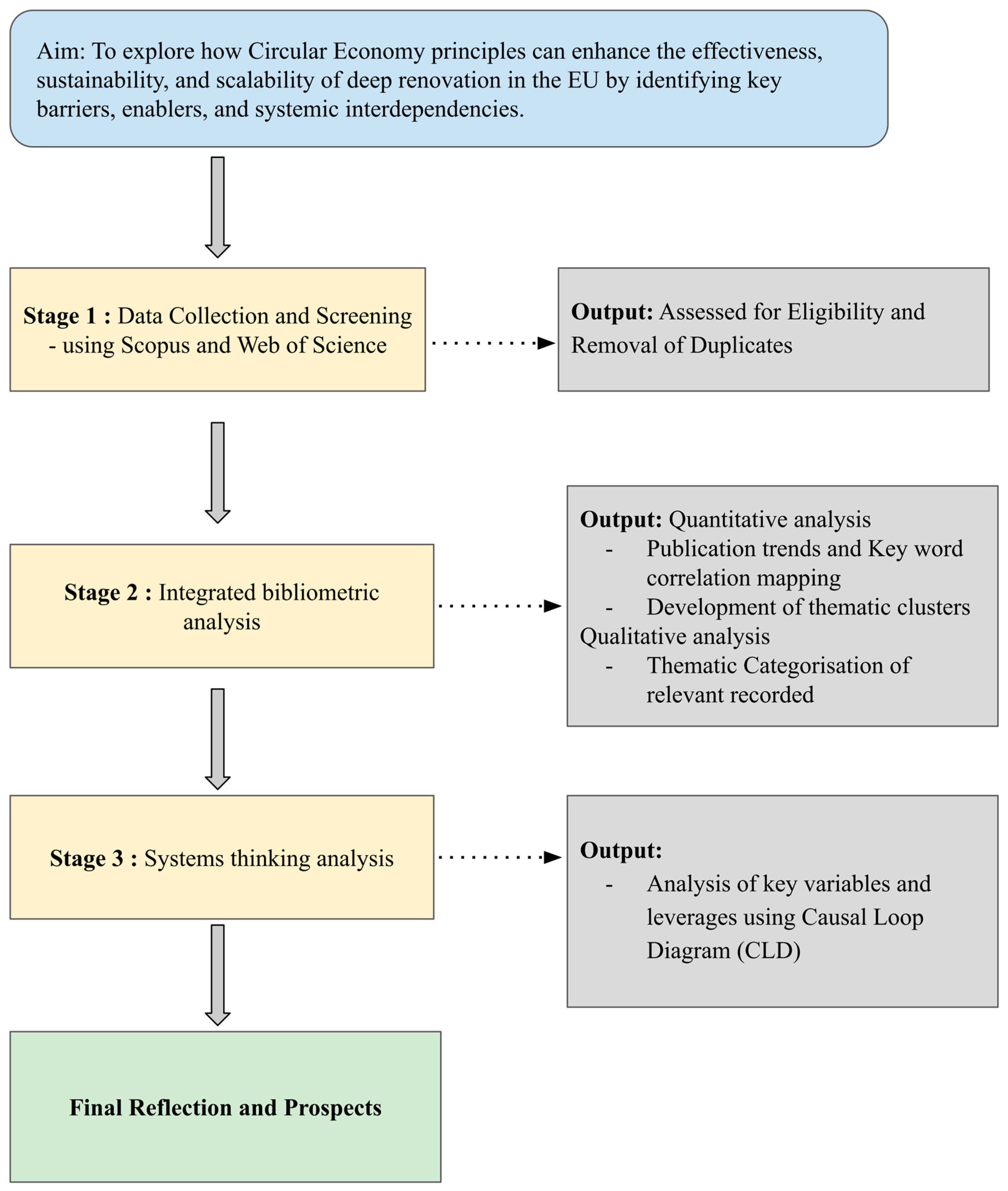
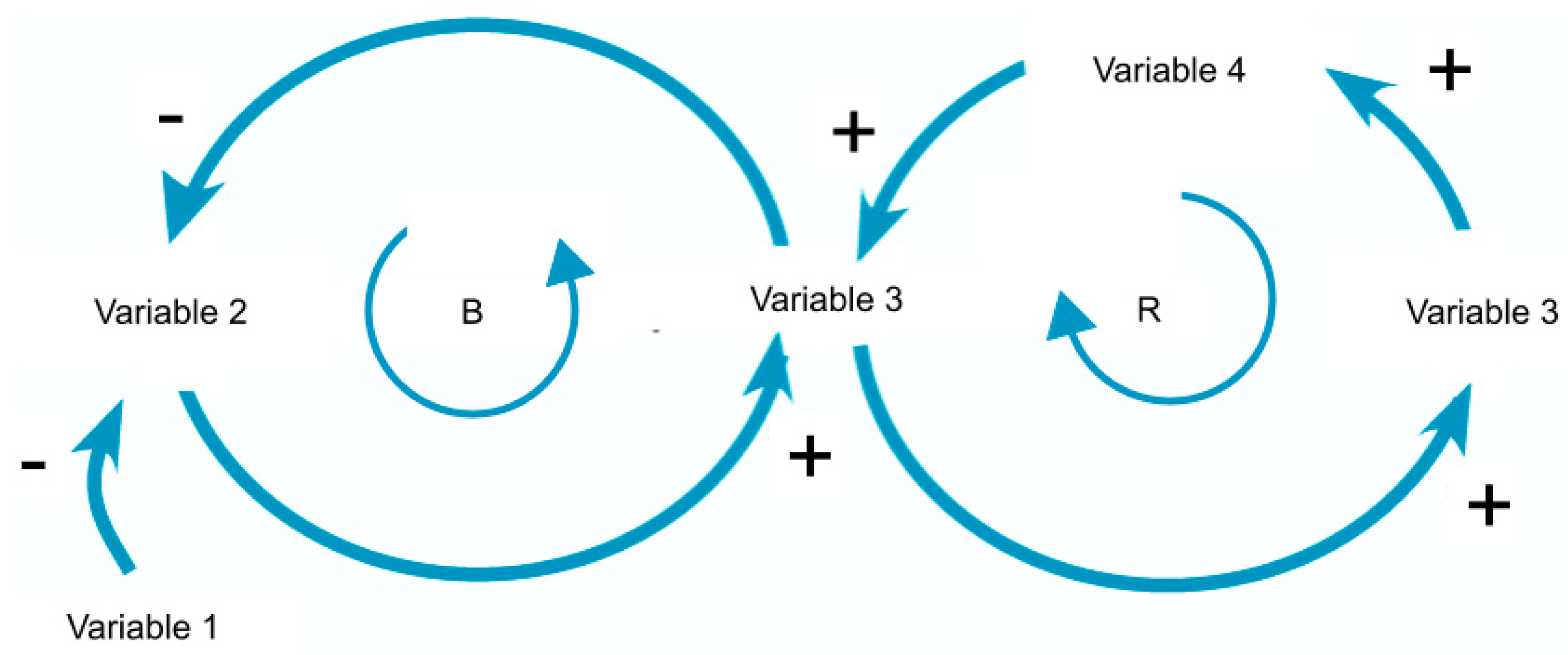
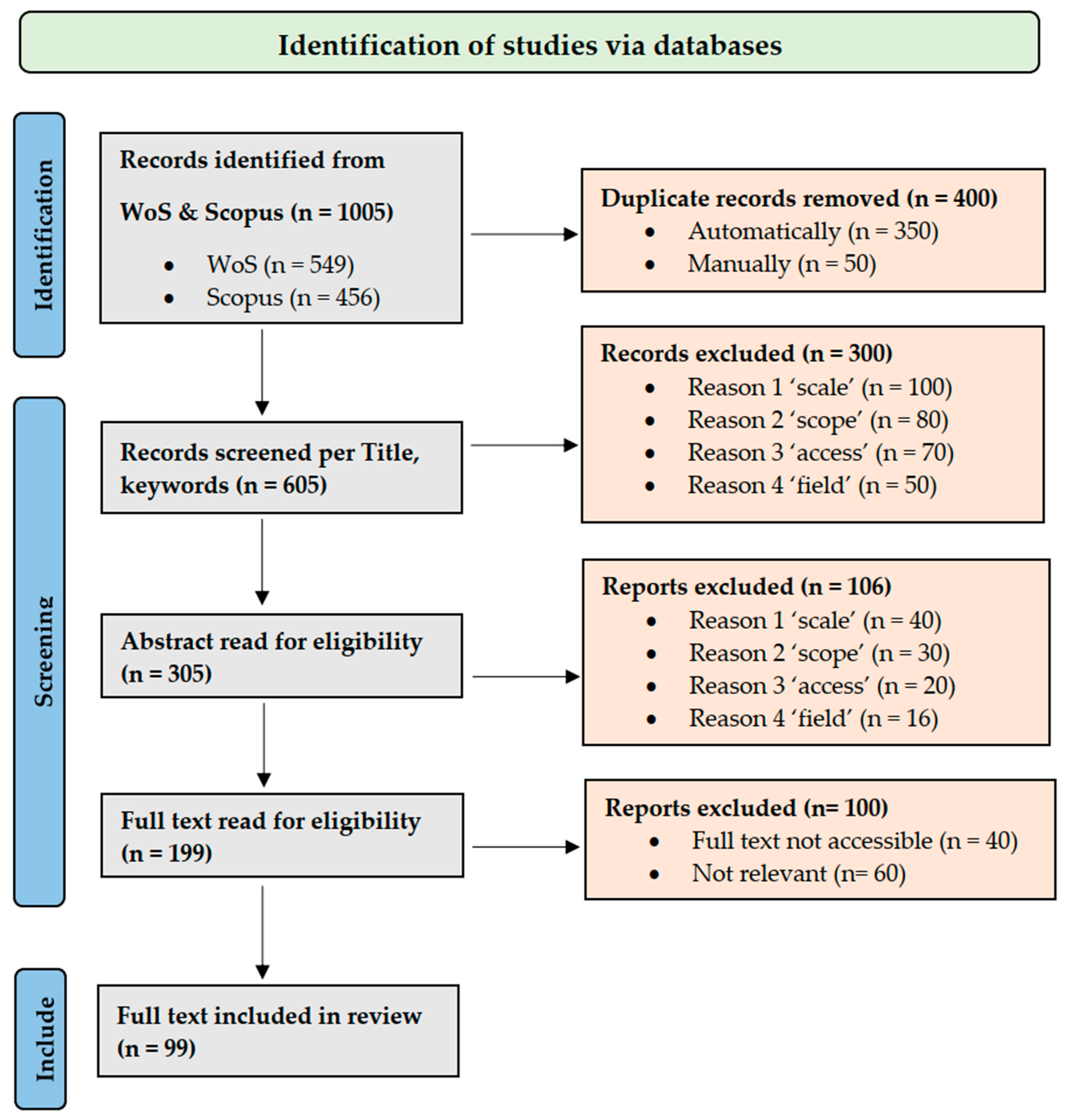
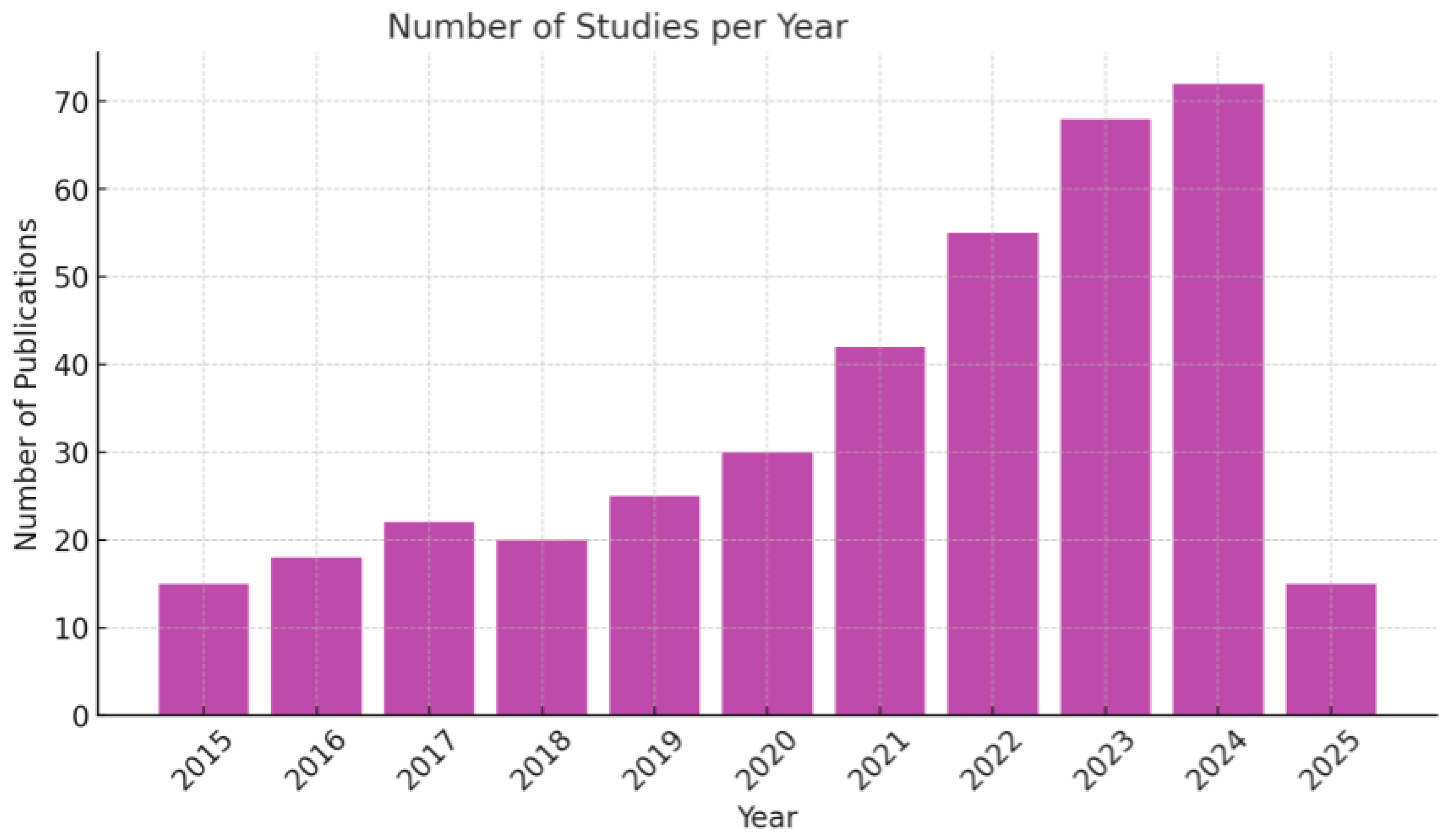
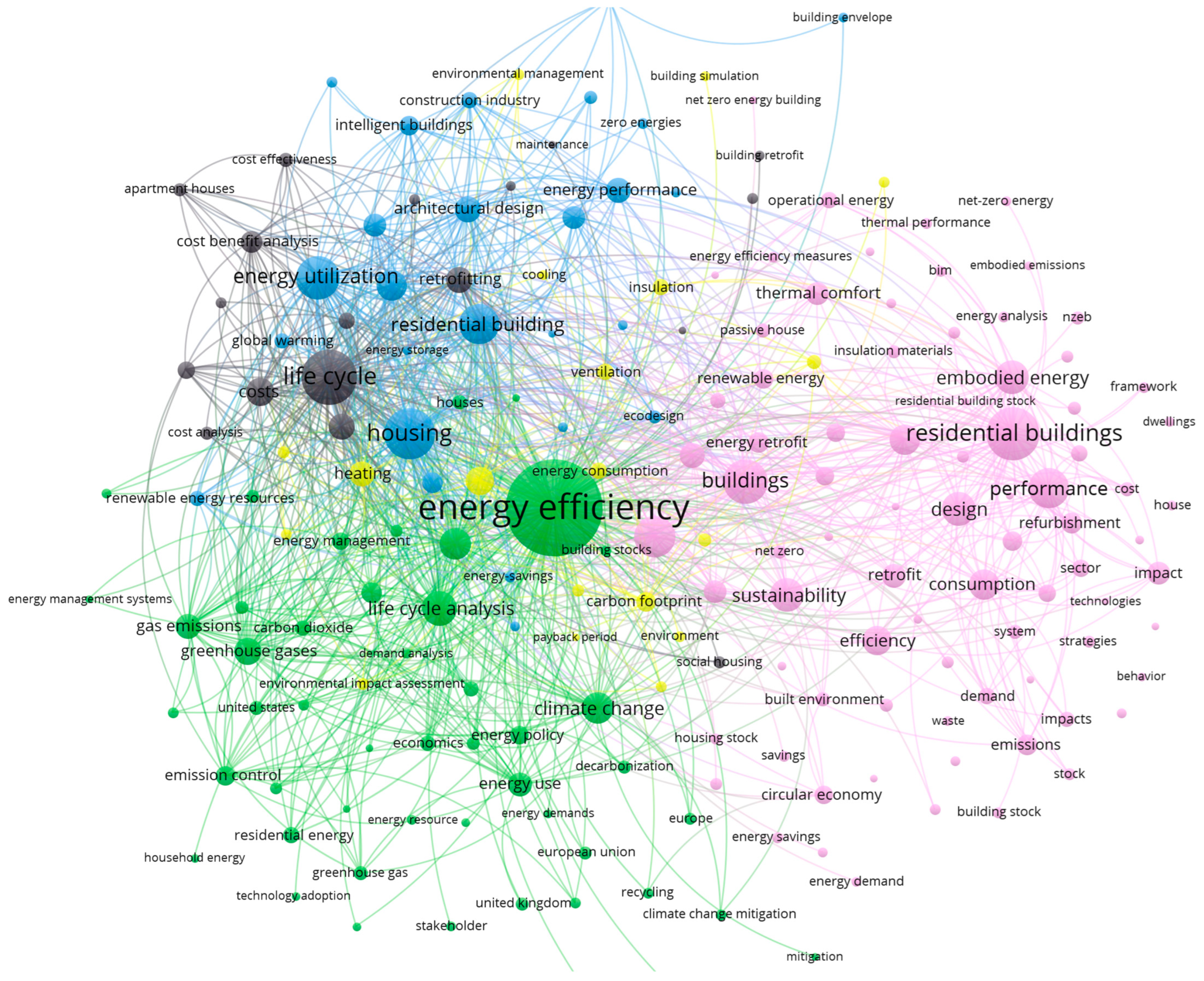
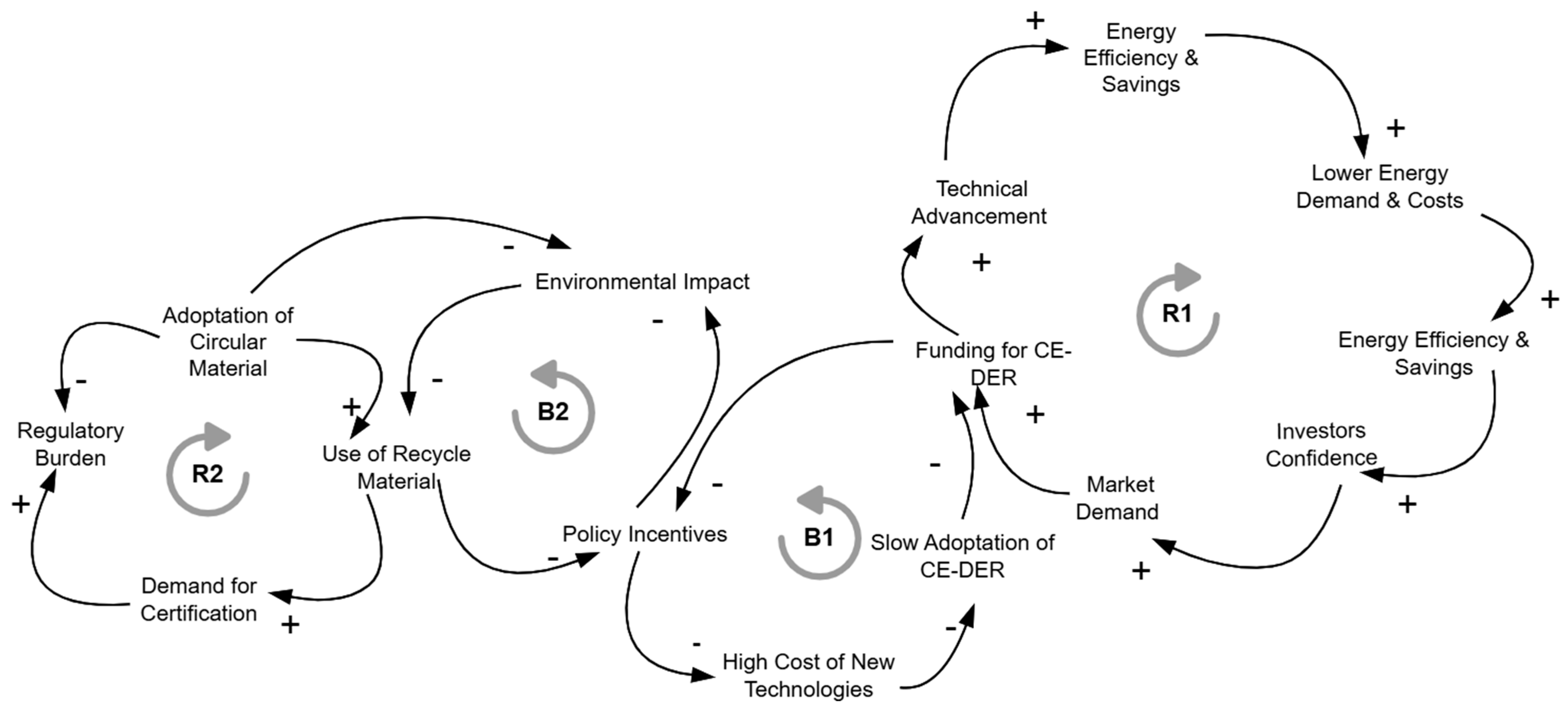
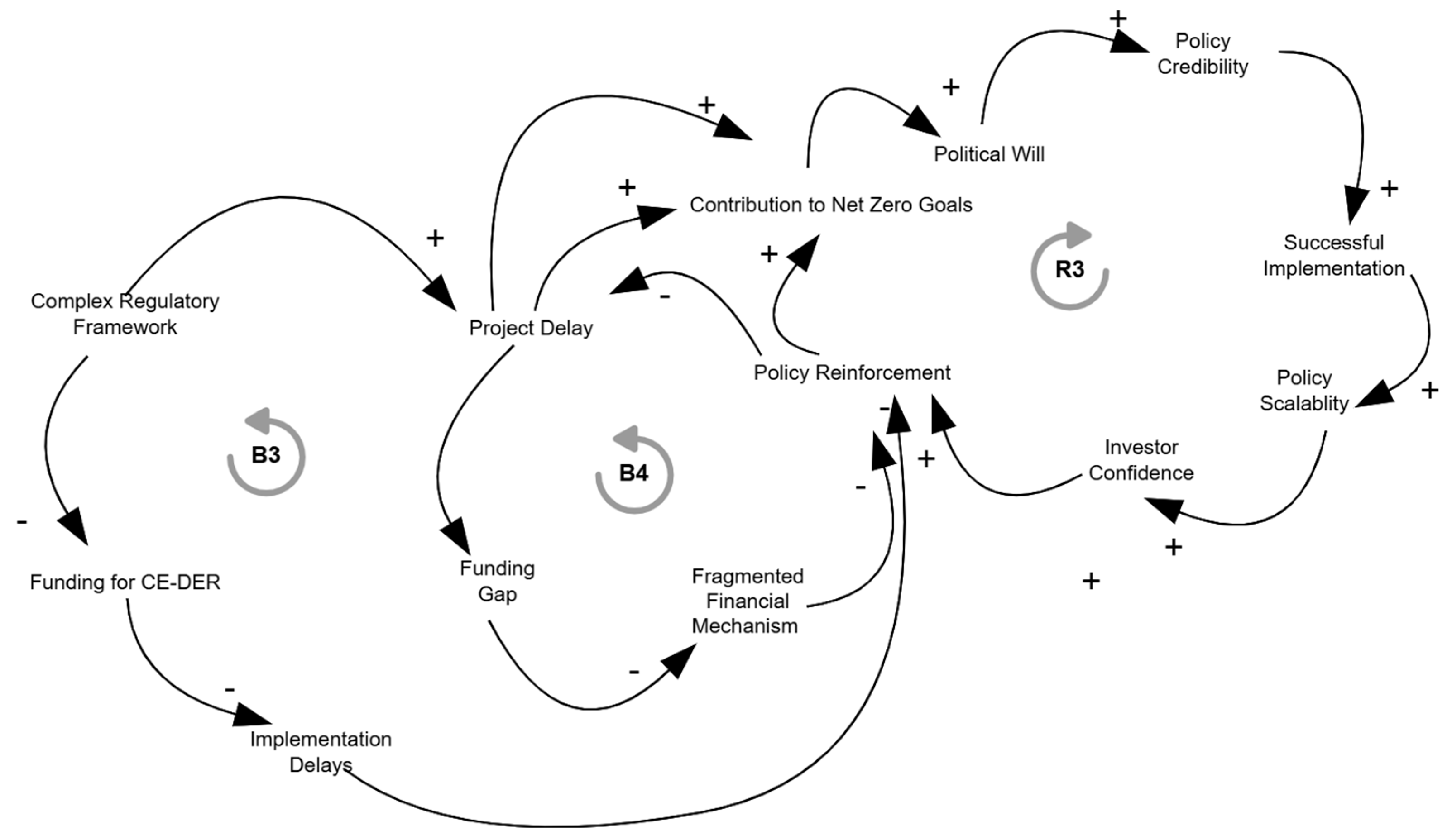
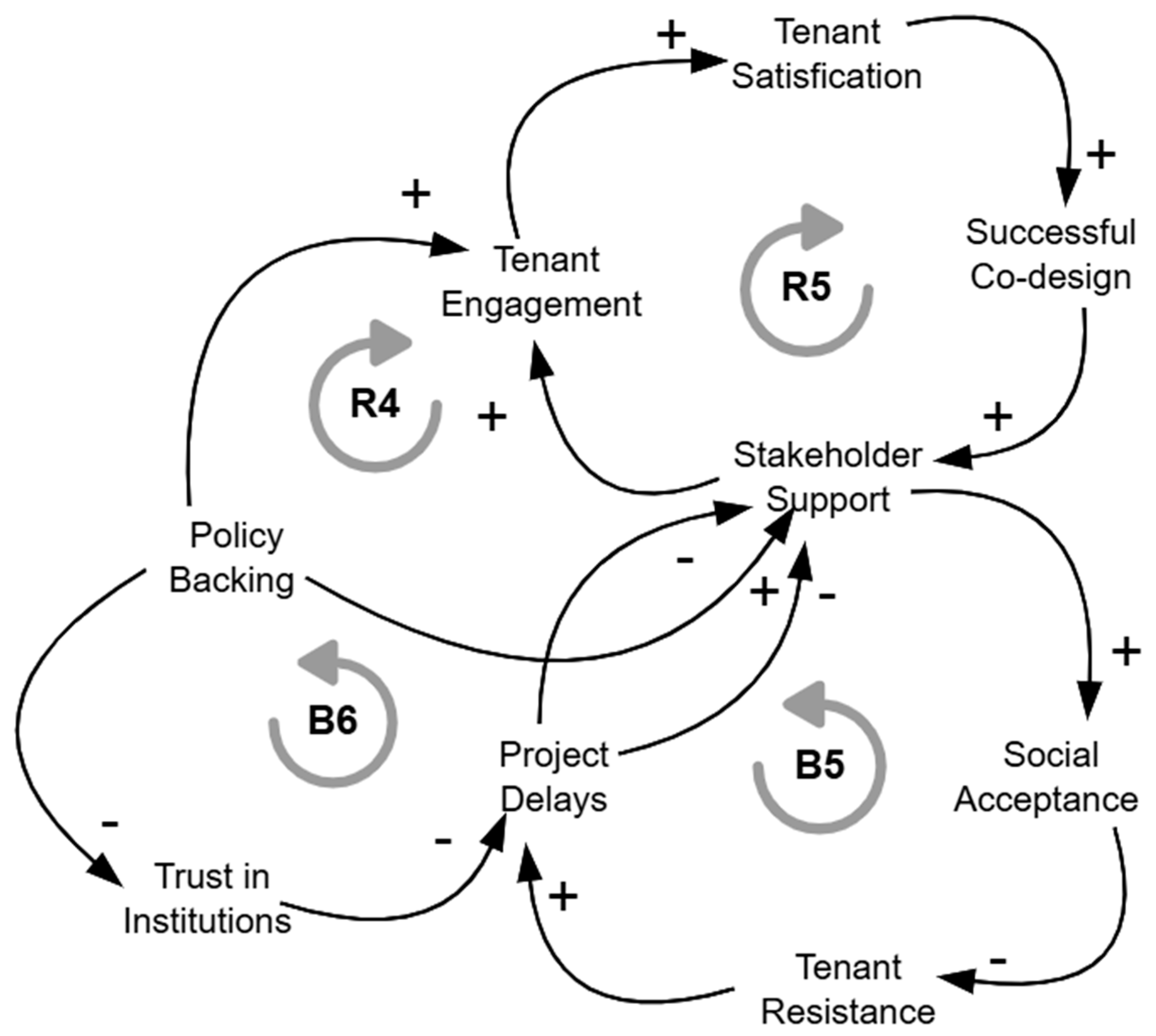
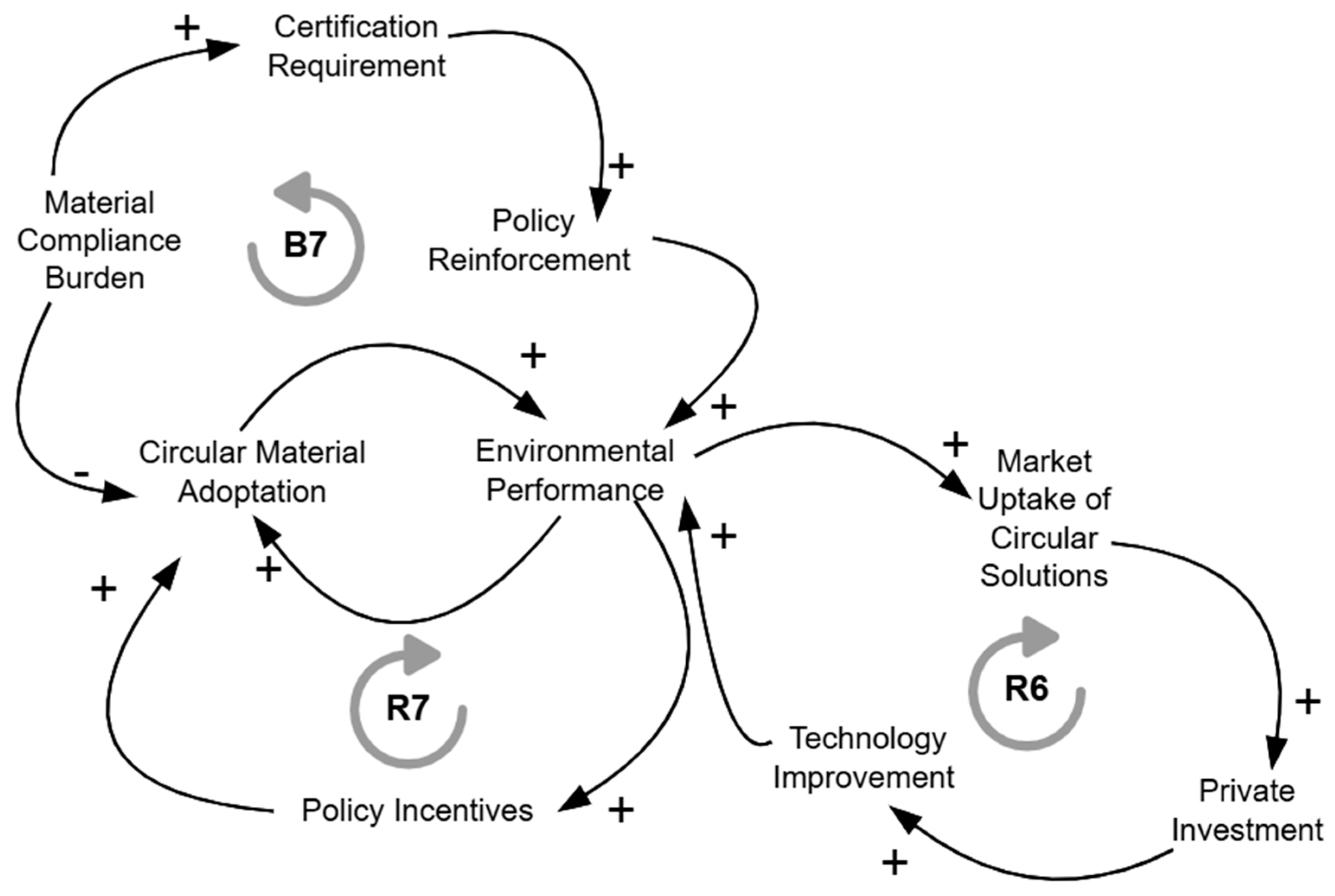

| 3W Framework | Keywords Used in Boolean Search |
|---|---|
| What? (Key thematic concepts: Circular Economy and Energy Renovation) | “Circular Econo* OR “Circular const*” OR “Material re*” OR “Resource efficiency” OR “Net Zero” AND “Deep Reno*” OR “Energy Retrofi*” OR “Energy efficien*” OR “Building renov*” OR “Sustainable construction” OR “Low-carbon buildings” |
| Who? (Relevant stakeholders: Policymakers, professionals, building occupants and other key actors) | “Stakeholder*” OR “Tenants” OR “Building owners” OR “Urban planners” OR “Policy makers” OR “Construction industry” |
| Where? (Targeted built environment: Housing and existing building stock) | “Housing” OR “Apartment*” OR “Social housing” OR “Public housing” OR “Existing buildings” |
| Database | Relevant Research/Subject Areas |
|---|---|
| Web of Science (WoS) | Environmental Sciences and Ecology Construction and Building Technology Engineering Energy and Fuels Architecture Urban Studies and Regional Planning Green Sustainable Science and Technology |
| Scopus | Energy Environmental Science Social Science Engineering |
| Clusters | Relevant Records |
|---|---|
| Technical Enablers | Sánchez Ramos et al., 2019 [31]; Wu et al., 2017 [32]; Storck et al., 2023 [33]; Passoni et al., 2022 [8]; Antonov et al., 2021 [34]; Antonov et al., 2020 [35]; Kuusk and Kalamees, 2016 [36]; Abbà et al., 2024 [37]; Dey et al., 2023 [38]; Gubert et al., 2023 [39]; Nigumann et al., 2024 [40]; Niemelä et al., 2017 [41]; Walker et al., 2022 [42]; Seo and Foliente, 2021 [43]; Szymańska et al., 2022 [44]; Sáez-de-Guinoa et al., 2022 [12]; Ma’bdeh et al., 2023 [45]; Kaewunruen et al., 2019 [46]; Lingard, 2021 [47]; Österbring et al., 2019 [48]; Attia et al., 2017 [49]; Moran et al., 2020 [50] |
| Economic and Policy Barriers | Fabbri et al., 2023 [51]; van der Schoor, 2022 [30]; Singh et al., 2019 [52]; Triantafyllopoulos, 2024 [53]; Lassandro et al., 2024 [54]; Jerome et al., 2021 [55]; Palladino, 2023 [56]; Ruggieri et al., 2023 [3]; Prabatha et al., 2023 [57]; Capelo et al., 2023 [58]; Barrella et al., 2023 [59]; Tingey et al., 2021 [60]; Konstantinou et al., 2020 [61]; Toleikyte et al., 2018 [62]; Horvath, 2017 [18]; Filippidou et al., 2017 [63]; Copiello et al., 2017 [64]; Thomas et al., 2024 [19] |
| Social Sustainability Factors | Mohareb et al., 2022 [65]; Marchi et al., 2023 [66]; Lucchi and Delera, 2020 [67]; Marchi and Gaspari, 2023 [68]; Shwashreh et al., 2024 [69]; Omar & Galal Ahmed, 2024 [70]; Shirani et al., 2022 [71]; Charles et al., 2025 [72]; Fowler Davis and Davies, 2025 [9]; Coyne et al., 2018 [73]; Sarmiento and Sims, 2015 [74]; Varady et al., 2015 [75]; Davis et al., 2024 [76]; Wågø et al., 2016 [77]; Camprubí et al., 2016 [78]; Fang et al., 2016 [79]; Braubach and Ferrand, 2013 [80] |
| Environmental Considerations | Ghisellini et al., 2016 [29]; Munaro et al., 2020 [81]; Almeida et al., 2018 [20]; Sojkova et al., 2019 [82]; Cal et al., 2021 [83]; Barbosa et al., 2022 [84]; Chandrasekaran et al., 2021 [85]; Soust-Verdaguer et al., 2023 [86]; Mer-cader-Moyano et al., 2020 [87]; Bragadin et al., 2023 [88]; Mercader-Moyano and Ramos-Martín, 2020 [7]; Cottafava and Ritzen, 2021 [89]; Chandrasekaran and Dvarionienė, 2022 [90]; Ghose et al., 2017 [91]; Schau & Prelovšek Niemelä, 2024 [92]; García-Pérez et al., 2018 [93]; Omrany et al., 2020 [94]; Pombo et al., 2016 [4]; Benedetti et al., 2025 [95]; Pittau et al., 2019 [96]; Paleari et al., 2016 [97] |
| Digitization and Data-Driven Systems for Climate Resilience | Sassanelli et al., 2019 [98]; Cangelli et al., 2024 [99]; Kaewunruen et al., 2024 [6]; Mazzoli et al., 2022 [100]; Klingler et al., 2025 [101]; Vergerio et al., 2018 [102]; Ca-puto and Pasetti, 2017 [103]; Fořt et al., 2022 [104]; Abram et al., 2022 [105]; Gaspari et al., 2021 [106]; D’Oca et al., 2018 [21]; Tretter, 2015 [107]; Kivimaa and Martiskainen, 2018 [108]; Tetteh et al., 2022 [109]; Sáez-de-Guinoa et al., 2022 [12]; Rahla et al., 2021 [110]; Becker et al., 2020 [111]; Pallett et al., 2019 [112]; Ness and Xing, 2017 [113]; Monzón-Chavarrías et al., 2021 [114] |
| Cluster | Key Reinforcing Loops (R) | Key Balancing Loops (B) | Leverage Point or Insight |
|---|---|---|---|
| Cluster 1—Technical Enablers | R1: Innovation–Efficiency–Investment R2: Circular Incentives and Uptake | B1: Tech Cost Barrier B2: Certification Bottleneck | Aggregate public investment to reduce tech cost and reform certification standards. |
| Cluster 2—Economic and Policy Barriers | R3: Policy Learning and Institutional Reform | B3: Regulatory Delay B4: Financial Fragmentation | Use pilot success to strengthen policy credibility and integrate fragmented finance. |
| Cluster 3—Social Sustainability Factors | R4: Policy Trust and Support R5: Co-Design and Satisfaction | B5: Resistance from Past Experience B6: Institutional Trust Erosion | Support co-design and early engagement to prevent resistance and delays |
| Cluster 4—Environmental Considerations | R6: Market Uptake and Private Investment R7: Circular Incentive Effectiveness | B7: Certification and Material Compliance Burden | Balance compliance with incentives to boost environmental outcomes and innovation |
| Cluster 5—Digitalization and Data-Driven Systems for Climate Resilience | R8: Evidence-Based Policy Feedback R9: Operational Efficiency Gains | B8: Privacy Concern and Stakeholder Resistance | Build trust through transparent data governance and adaptive digital tools. |
Disclaimer/Publisher’s Note: The statements, opinions and data contained in all publications are solely those of the individual author(s) and contributor(s) and not of MDPI and/or the editor(s). MDPI and/or the editor(s) disclaim responsibility for any injury to people or property resulting from any ideas, methods, instructions or products referred to in the content. |
© 2025 by the authors. Licensee MDPI, Basel, Switzerland. This article is an open access article distributed under the terms and conditions of the Creative Commons Attribution (CC BY) license (https://creativecommons.org/licenses/by/4.0/).
Share and Cite
Raut, S.A.; Marchi, L.; Gaspari, J. A System Thinking Approach to Circular-Based Strategies for Deep Energy Renovation: A Systematic Review. Energies 2025, 18, 2494. https://doi.org/10.3390/en18102494
Raut SA, Marchi L, Gaspari J. A System Thinking Approach to Circular-Based Strategies for Deep Energy Renovation: A Systematic Review. Energies. 2025; 18(10):2494. https://doi.org/10.3390/en18102494
Chicago/Turabian StyleRaut, Shantanu Ashok, Lia Marchi, and Jacopo Gaspari. 2025. "A System Thinking Approach to Circular-Based Strategies for Deep Energy Renovation: A Systematic Review" Energies 18, no. 10: 2494. https://doi.org/10.3390/en18102494
APA StyleRaut, S. A., Marchi, L., & Gaspari, J. (2025). A System Thinking Approach to Circular-Based Strategies for Deep Energy Renovation: A Systematic Review. Energies, 18(10), 2494. https://doi.org/10.3390/en18102494








